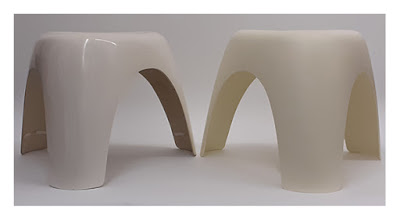MoDiP has been fortunate enough to acquire two versions of Sori Yanagi’s Elephant Stool (see image below), a renowned example of Japanese post-war design and believed to be the world’s first completely synthetic stool.
 |
|
Image ref: MoDiP’s Elephant Stools,
manufactured by Habitat (left) and Vitra (right).
Image credit: Katherine Pell |
Originally designed by Yanagi in 1954 as a work chair for his studio, the stool was commercially released by Japanese manufacturer Kotobuki two years later, after the company had developed the technology for mass producing glass-reinforced plastic (GRP). This material was first introduced into furniture through the launch of the Eames’ chair in 1950, a one-piece, moulded seat shell which could be combined with a variety of bases. By utilising GRP’s strength and rigidity, Yanagi was able to achieve the stability he required for his sculptural, curved-leg design. In 1960, it won the gold medal at the 12th Triennale di Milano, in a display showcasing Japanese plastics manufacturing and mass production capability.
 |
|
Image ref: Can you see the elephant?
Image credit: Katherine Pell |
The unique design quickly became known as the Elephant Stool because the form evoked a stylised trunk when viewed head-on and, because the material was waterproof, it soon became popular for use outdoors: it is quite common to find Japanese examples that have had holes drilled in for extra drainage. Kotobuki continued production until the late 1970s, then only making stools to order until 2000.
 |
Image ref: Habitat advert for the stool,
retailing at £39 (AIBDC
: 003087, p. 97).
Image credit: Katherine Pell |
That same year, Habitat, as part of its 20th
century classics range, collaborated with Yanagi to re-release the stool in GRP
with a small, rubber cushion added underneath the seat to protect the furniture
when stacked. Unfortunately, quality issues caused production to cease after
only a few years. In 2004, it was re-engineered by Vitra, alongside Yanagi, to create
a model in polypropylene that was still faithful to the original design. It is
these last two examples that MoDiP has now added to the collection, both in
white for ease of comparison.
 |
|
Image ref: The GRP material of the Habitat stool (left) and Yanagi’s logo on the polypropylene Vitra model (right). Image credit: Katherine Pell |
Sori Yanagi (1915 – 2011) was
successful in combining his own cultural upbringing with ideas of Western
Modernism. He fostered a deep appreciation of Japanese folk art and craft
processes through his father, who had founded the mingei movement in the 1920s. He studied at the Western Painting
Department of the Tokyo Fine Arts School, graduating in 1940. He
then began working with French architect and industrial designer
Charlotte Perriand, who was acting as an advisor to the Japanese Ministry of
Trade and Industry, where he became interested in product design. Between
1942-1945 he worked as a researcher at the Junzo
Sakakura Institute of Architecture and, after a period of military
service, returned to Japan in 1946 to begin research into industrial design,
opening the Yanagi Industrial Design Institute in
1950.
 |
Image ref: A selection of Yanagi’s designs.
Image credit: https://www.japanhouselondon.uk/discover/stories/yanagi-sori-s-design-story/ |
In addition to the
Elephant stool, his body of work includes the iconic Butterfly stool, another
celebrated furniture design, as well as a range of porcelain, various kitchenware,
an Olympic torch (twice), a bridge and even a motorbike! He also wrote and
presented widely on the subject of design, taught at several universities, was
appointed director of the Japan Folk Crafts Museum in 1977 and received numerous
awards throughout an illustrious career. At the age of 89 he was still
advocating designing in traditional ways, starting with pencilled drawings and
then sculpting prototypes; a philosophy he called ‘thinking by hand’.
 |
Image ref: Sori Yanagi with an early hand sculpted prototype of the Elephant stool. Image credit: https://www.sg.emb-japan.go.jp/JCC/SoriYanagi_PR_JCC.pdf |
References:
http://collectiononline.design-museum.de/#/en/object/43045?_k=ee6p0q
https://collections.vam.ac.uk/item/O1387355/stool/
https://mapptokyo.wordpress.com/2011/01/26/sori-yanagi-design-butterfly-elephant-stool/
https://npo-plat.org/yanagi-sori.html
https://www.japanhouselondon.uk/discover/stories/yanagi-sori-s-design-story/
https://www.kotobuki-seating.co.jp/en/about/history.html
https://www.metropolismag.com/uncategorized/qa-sori-yanagis-elephant-stool-for-vitra/
https://www.moma.org/collection/works/133820
https://www.sg.emb-japan.go.jp/JCC/SoriYanagi_PR_JCC.pdf
https://www.smow.com/freiburg/vitra/elephant-stool.html











